
Most photographers prefer using ambient light to capture the world around them. It provides softer hues and a more authentic look to your shots. But that doesn't mean you should write off your flash. It can help sharpen your images, highlight certain features, or add creative effects to your photos.
So what exactly is a camera flash and how does it work?

Flash through History
It wasn't until the late 19th century that photographers found a way to capture subjects and locations with little ambient light. The technology began with powders and lamps, before progressing to the flash bulbs and electronic flashes we're familiar with today.
Flash Powder & Flash Lamps
The first form of camera flash was flash powder, which was a mixture of magnesium powder and potassium chlorate. When a small amount was ignited, it would produce a flash.
Flash powder was very volatile, so it was common for accidents to happen as photographers attempted to light the powder - unsurprising when you consider it is still used today in fireworks. Imagine risking life and limb to capture a great photo!
To prevent photographers and subjects from getting injured, flash lamps were developed in 1899. These lamps had a trough that stored flash powder, which was ignited by electricity from a dry cell battery. Most camera flash lamps were connected to camera box shutters, so flashes could be activated when you press the shutter, much like they do today.
Flash Bulbs
In the 1920s, photographers started seeing flash bulbs, a glass bulb containing a magnesium filament and oxygen gas. Each bulb only survived one flash, so the photographer would have to swap them out after every use.

Flashcubes & Flipflash
In the sixties Kodak introduced the Flashcube, which gave photographers four flashbulbs in one cubed package, so there was no need to swap out the flash after every photo.
Polaroid, Phillips and General Electric were such fans of the idea, they created their own versions. GE’s version was called the Flipflash, which offered photographers eight to ten shots per cartridge.
Electronic Flashes
As we moved toward the end of the 20th century the flash advanced rapidly. Electronic flashes did away with the one-flash option, making it possible for photographer to capture as many scenes with flash as they wanted. They are simple to use, affordable and far safer than their predecessors.

Electronic flashes produce a short and bright burst of light as you press the shutter release, only illuminating your subject for a moment, as the film or sensor is exposed.
A modern electronic camera flash system consists of three main parts:
- A gas discharge unit, usually with xenon gas, which produces the flash
- A power supply, like a small battery
- An electrical circuit that connects the power supply and gas tube.
When you activate your flash and press the shutter button, the electrical circuit increases the power supply's electrical current. This feeds energy into the xenon gas, which causes it to emit a bright flash.
Once the process is complete and you have captured your photo, the flash resets to its previous state, ready to capture more photos.
It's a wonder that what was once a process fraught with hazards is now so simple we don't even think about it!
If you’re looking for the best equipment for low light photography, including flash guns and accessories, check out our full range of lighting and accessories today.
